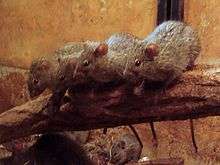African grass rat
| African grass rat | |
|---|---|
 | |
| Scientific classification | |
| Kingdom: | Animalia |
| Phylum: | Chordata |
| Class: | Mammalia |
| Order: | Rodentia |
| Family: | Muridae |
| Genus: | Arvicanthis |
| Species: | A. niloticus |
| Binomial name | |
| Arvicanthis niloticus (É. Geoffrey, 1803) | |
The African grass rat (Arvicanthis niloticus) is a species of rodent in the family Muridae.
Taxonomy
The species is divided into the following six subspecies.
- A.n.niloticus: Nile, Egypt;
- A.n.dembeensis (<span style=#font-variant: small-caps">Rüppell, 1842): Sudan, Ethiopia, Eritrea; Tanzania, Kenya, Burundi, Uganda Democratic Republic of Congo;
- A.n.naso (<span style=#font-variant: small-caps">Pocock, 1934): Yemen;
- A.n.rhodesiae (<span style=#font-variant: small-caps">St.Leger, 1932): Zambia;
- A.n.solatus (<span style=#font-variant: small-caps">Thomas, 1925): Senegal; Mauritania, Mali, Niger, Chad, Burkina Faso, Ghana, Nigeria, Cameroon and Central African Republic;
- A.n.testicularis (<span style=#font-variant: small-caps">Sundevall, 1843): upper Nile, central Sudan.[1]
Description
Arvicanthis niloticus is a rodent of medium size, with the length of the head and of the body between 159 and 202 mm, the length of the tail between 125 and 173 mm, the length of the foot between 33 and 42 mm, the length of the ears between 19 and 23 mm and a weight up to 201 g.[2]
The fur is rough. The upper parts of individual hairs are yellowish with blackish tips. Long yellow or orange hairs are present on the bottom. A dorsal dark stripe more or less distinct extends from the head to the base of the tail. The ventral parts are whitish, with the base of the hairs blackish.
Areas where there are the whiskers, the eyes and a small patch behind each ear are orange. The legs are pink. The tail is shorter than the head and body, densely covered with hair, blackish above and white-yellowish below. The karyotype is 2n = 62, FN = 62-64.
Distribution
It is mainly distributed in the Sahel and the sudano-zambesian Savanna belt, namely Benin, Burkina Faso, Burundi, Central African Republic, Chad, Democratic Republic of the Congo, Ivory Coast, Eritrea, Ethiopia, Gambia, Ghana, Kenya, Malawi, Mauritania, Niger, Nigeria, Senegal, Sierra Leone, Sudan, Tanzania, Togo, Uganda, and Zambia. Populations also occur in Algeria, Egypt, and Yemen.
Cycle of life
Despite its wide distribution and commonness, little is known about the biology and actual occurrence of the species. It reproduces mainly between June and November. The females give birth to 5-6 small cubs at least 3-4 times a year. Life expectancy in the wild is 2.5–3 years.
Habitat
Its natural habitats are dry savanna, moist savanna, subtropical or tropical moist shrubland, arable land, pastureland, rural gardens, urban areas, irrigated land, and seasonally flooded agricultural land.
References
- ↑ Glover M.Allen (1939). A checklist of African Mammals
- ↑ Dale J. Osborn & Ibrahim Helmy (1980). The contemporary land mammals of Egypt
- Granjon, L. (2008). "Arvicanthis niloticus". IUCN Red List of Threatened Species. Version 2013.2. International Union for Conservation of Nature. Retrieved 4 May 2014.
- Musser, G.G.; Carleton, M.D. (2005). "Superfamily Muroidea". In Wilson, D.E.; Reeder, D.M. Mammal Species of the World: A Taxonomic and Geographic Reference (3rd ed.). Johns Hopkins University Press. pp. 894–1531. ISBN 978-0-8018-8221-0. OCLC 62265494.
